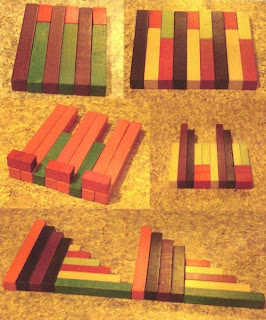The pictures that follow are pretty much self-explanatory, but I do have a few general suggestions. First of all, keep it fun– don’t frustrate. Reverse roles with your little person sometimes and let him create a ‘train’ for you to continue. Obviously, don’t use coins or very small objects with very young children who might swallow them. (Note- coins can be washed and probably should be.) And finally, I have found that verbalizations are very helpful to understanding a sequence. For example, a very simple train might be a sequence of alternating red and white blocks. Saying or chanting “red-white, red-white, red-white” as you lay down the pattern helps clarify the intent. Your little person can continue the “red-white, red-white, red-white” chant as she continues the train.
As train sequences become more complex, not only color and size can be varied, but positioning variations (vertical, horizontal) can also be used.
Red-Yellow, Red-Yellow, Red-Yellow...
White-White-Red, White-White-Red...
Purple Up-Red Down-White, Purple Up-Red Down-White, Purple Up-Red Down-White...

Green Up-White-Green Down, Green Up-White-Green Down, Green Up-White-Green Down...
Yellow-DoubleRed, Yellow-DoubleRed, Yellow-DoubleRed...
White-White-White-DownPurple-UpRed, White-White-White-DownPurple-UpRed...

Pattern Block Trains
More Pattern Block Trains
Lego Trains (More Views of the Same Trains Below)
Coin Trains: Dime-Penny-Penny, Dime-Penny-Penny..., Penny-Quarter, Penny-Quartr..., and Penny-Penny-Penny-Penny-Penny-Nickel, Penny-Penny-Penny-Penny-Penny-Nickel... or, One-Penny-Two-Pennies-Three-Pennies-Four-Pennies-Five-Pennies-Nickel, One-Penny-Two-Pennies-Three-Pennies-Four-Pennies-Five-Pennies-Nickel...




























